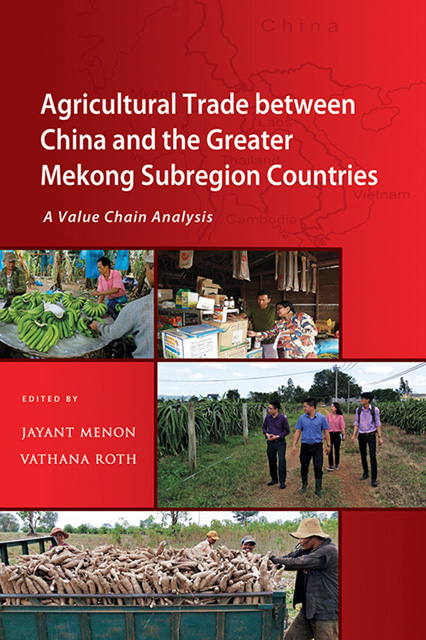Book contents
- Frontmatter
- Contents
- List of Tables
- List of Figures
- List of Annexes
- Foreword
- Preface
- Acknowledgements
- Abbreviations and Acronyms
- The Contributors
- 1 Agricultural Trade between China and the Greater Mekong Subregion Countries: An Overview
- 2 Economic Structural Change in China and the Implications for Agricultural Trade in the Lancang-Mekong Region
- 3 Agricultural Exports from Thailand to China: A Value Chain Analysis of Cassava and Durian
- 4 Agricultural Exports from Cambodia to China: A Value Chain Analysis of Cassava and Sugarcane
- 5 Agricultural Exports from Laos to China: A Value Chain Analysis of Rice and Cavendish Banana
- 6 Agricultural Exports from Myanmar to China: A Value Chain Analysis of Maize
- 7 Agricultural Exports from Vietnam to China: A Value Chain Analysis of Dragon Fruit and Coffee
- Index
2 - Economic Structural Change in China and the Implications for Agricultural Trade in the Lancang-Mekong Region
Published online by Cambridge University Press: 30 June 2023
- Frontmatter
- Contents
- List of Tables
- List of Figures
- List of Annexes
- Foreword
- Preface
- Acknowledgements
- Abbreviations and Acronyms
- The Contributors
- 1 Agricultural Trade between China and the Greater Mekong Subregion Countries: An Overview
- 2 Economic Structural Change in China and the Implications for Agricultural Trade in the Lancang-Mekong Region
- 3 Agricultural Exports from Thailand to China: A Value Chain Analysis of Cassava and Durian
- 4 Agricultural Exports from Cambodia to China: A Value Chain Analysis of Cassava and Sugarcane
- 5 Agricultural Exports from Laos to China: A Value Chain Analysis of Rice and Cavendish Banana
- 6 Agricultural Exports from Myanmar to China: A Value Chain Analysis of Maize
- 7 Agricultural Exports from Vietnam to China: A Value Chain Analysis of Dragon Fruit and Coffee
- Index
Summary
INTRODUCTION
China’s trade in agricultural goods depends essentially on three factors: demand, supply and the policies that affect them. Although China’s agricultural exports and imports are primarily determined by the interaction of supply and demand, both trade and agricultural policies are also important. Even if a country has to import agricultural goods, the tariffs on those goods may be high because the government must also consider protecting domestic farmers.
Changes in population, urban-rural structure, and dietary habits are the fundamental variables affecting China’s food demand. China’s population is expected to peak by around 2030 at 1.45 billion to 1.5 billion, with more than 1 billion living in cities and an elderly population of about 500 million. As a result, the total consumption of main grains is expected to decline while the consumption of meat, eggs, milk, fruit, vegetables and special grains will grow.
From the domestic supply-side, China’s current grain production capacity is 620 million tonnes, of which wheat straw- and rice strawbased rations account for about 390 million tonnes and corn-based feed for 230 million tonnes. According to current agricultural and arable land resource potential, production systems and technology management, China has reached its limit of food production capacity. Unless there is disruptive technology, it will be hard to envision and plan for a future of growth.
As for relevant policies, the Chinese government has introduced a food security policy of “ensuring basic self-sufficiency of grain and absolute security of staple food” (State Council Information Office of China 2019). The national food security strategy features self-sufficiency based on domestic grain production, guaranteed food production capacity, moderate imports, and technological support.
China’s food security policy and strategy are unlikely to change in the short to medium term. Its imports of grains and staple foods will therefore remain low, but imports of other agricultural products, especially landintensive agricultural goods, will increase significantly. China will still impose import tariff quotas on wheat, corn and rice, but will slash import tariffs on other grains and continue to eliminate non-tariff measures such as import quotas and licences for related agricultural product.
At present, research on China’s agricultural products trade has focused on China’s overall exports and imports, with less emphasis on China’s agricultural economic and trade cooperation with specific countries, especially Lancang-Mekong countries.
- Type
- Chapter
- Information
- Agricultural Trade between China and the Greater Mekong Subregion CountriesA Value Chain Analysis, pp. 22 - 58Publisher: ISEAS–Yusof Ishak InstitutePrint publication year: 2022



